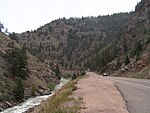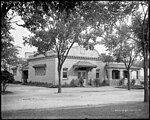Sand Creek (Denver, Colorado)
Rivers of Adams County, ColoradoRivers of Arapahoe County, ColoradoRivers of ColoradoTributaries of the Platte River

Sand Creek is a 14.6-mile-long (23.5 km) tributary that flows into the South Platte River near Commerce City, Colorado. From its source in unincorporated Arapahoe County, it flows through the cities of Aurora and Denver before joining the South Platte in Adams County.It is not to be confused with Big Sandy Creek (along which the Sand Creek Massacre occurred), which is over 100 miles to the southeast.
Excerpt from the Wikipedia article Sand Creek (Denver, Colorado) (License: CC BY-SA 3.0, Authors, Images).Sand Creek (Denver, Colorado)
Sand Creek Trail,
Geographical coordinates (GPS) Address Nearby Places Show on map
Geographical coordinates (GPS)
| Latitude | Longitude |
|---|---|
| N 39.813055555556 ° | E -104.95222222222 ° |
Address
Sand Creek Trail
Sand Creek Trail
80216
Colorado, United States
Open on Google Maps






